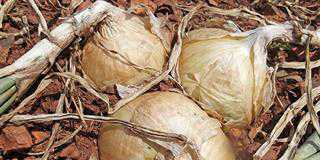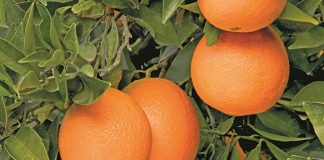Weed management is crucial, as weeds compete with plants for soil moisture, soil nutrients, light and carbon dioxide.
Several types of herbicides are available. Contact or scorch herbicides act through the leaves. Systemic herbicides are absorbed and spread throughout the plant by means of translocation. Both are applied to weeds after the weeds and papaya plants have emerged.
A pre-emergence or residual herbicide is applied to the soil, where it inhibits germination of weed seeds or is absorbed through the roots and spread by translocation.
Removing weeds
Weeds can be removed from under the trees by hand-hoeing. With tramline planting (where a working row area permits tractor movement), weeds can be mown with a rotary cutter, a slasher driven by a tractor.
Mechanical hoeing with a disc plough is not recommended because of damage to the soil structure and tree roots. Also, avoid implement traffic near the drip area to prevent compaction, as feeder roots are found in the top 400mm of the soil.
It is an excellent idea to put down mulch. This suppresses weeds, conserves soil moisture, stabilises soil temperature and improves soil structure.
Orchard sanitation
A good orchard sanitation programme can limit the incidence of leaf and fruit diseases. Remove old and dead leaves from the plants without damaging the fruit. Destroy leaves and spoilt fruit elsewhere.
Diseases and solutions
Common papaya diseases include the following:
- Damping off: This can occur at the pre-emergence stage, where seedlings do not emerge, or post-emergence where seedlings fall over and die. Anything that contributes to wet, humid conditions and lush, soft plants favours the condition. Use registered chemicals for seed treatment. Employ these and other chemicals as drench treatments or mix them with the growth medium.
- Powdery mildew: This causes defoliation, leaf distortion and fruit scarring. It is particularly severe during the dry winter months. Use a wettable sulphur (the only registered product for this purpose) to control powdery mildew on papayas. The recommended dosage is 300g/100l water. Apply when first symptoms are noticed and repeat at two-week intervals.
- Black spot: This disease reduces plant vigour, resulting in a lower yield of small, poor-quality fruit. The first symptoms appear as small round lesions on the undersurface of older leaves. On fruit, the first sign is the appearance of water-soaked lesions approximately 1mm in diameter on the exposed side. Black spot should be controlled with Mancozeb, the registered product for the treatment of this fungus, at 200g/100 litres water. Apply from flowering at 28- day intervals. If the disease becomes more severe, shorten the interval to every 14 days.
- Root rot: Infection first occurs on the roots or stem base. The older leaves wilt, droop and then die. Eventually, only a few leaves remain at the top of the tree, or the tree dies. Affected plants are easily blown or pushed over. No chemical is registered for the control of root rot on papayas, but it can be prevented with good soil drainage and avoiding damage to the roots or stem base.
Pests
In South Africa, root-knot nematodes (especially M. javanica and M. incognita) and reniform nematodes penetrate the roots and cause extensive physical and economic damage. Symptoms include sparse foliage and small leaves, exposing fruit to sunburn. Root rot risk is also increased.
To prevent it, ensure that the planting bags are free of nematodes. If soil is added to the growth medium, sterilise the medium with methyl bromide or steam.
Source: Directorate Agricultural Information Services, department of agriculture, in cooperation with the ARC-Institute for Tropical and Subtropical Crops. The foregoing is merely intended as an overview of papaya production. Consult an extension officer for area-specific guidance.













